In the last decade, Bitcoin has emerged as the most interesting form of money. When it was created back in 2009, the objective of the creator(s) was to create a medium of exchange that could bypass a central authority allowing people to transact using their digital identities. It has in fact revolutionized cryptocurrency and digital assets, re-exploring the global financial system. The indigenous Bitcoin network was designed as a peer-to-peer payment system that allows people to transfer value without any middleman. But with accelerating popularity Bitcoin’s design and architecture were gridlocked with congestion.
Enter Bitcoin Latinum
Initially, transaction fees existed with the purpose of deterring malicious actors from overloading the Bitcoin Network inspired by Adam Back’s hashcash system that relied on the Proof of Work system.
iner outages in China have slowed block production at a time when the demand has never been greater. Hence Bitcoin’s average transaction fees have surpassed their all-time highs. As per multiple sources, the average fee in April this year was close to $59. In 2017, when BTC reached its peak in the last bull market, the average transaction fees touched $50.
Processing transactions on the blockchain can be painstaking. The fees are used to compensate the validators to keep running things smoothly. A look into a comparison of transaction fees will make visible the state of affairs of Bitcoin transaction fees vis-a-vis its contemporaries.
Bitcoin Latinum is the third generation Bitcoin hard fork that is capable of huge transaction volumes with minimal transaction fees. It has been contrived with five fundamental elements to make the network self-sustaining and scalable:
- An energy-efficient consensus algorithm
- Faster transactions & lower latency network
- Security & Insurance
- Community government
- Future-enablement
It is based on the source code, algorithm, and protocol of Bitcoin. Being an open architecture technology, Bitcoin Latinum augments the Bitcoin code to operate with supreme security, high transactional speed, reliability, and lower transaction costs. The platform creates a decentralized financial network that would boost not just efficiency but secure digital asset transactions for media, gaming, cloud computing, and telecommunications.
Why Bitcoin Latinum is third Generation BTC
Bitcoin and Ethereum are legacy systems but both need innovation as they consume massive amounts of energy to operate. Bitcoin Latinum is the 3rd generation network that uses the energy-efficient Mutalized Proof of Stake consensus mechanism making it faster and costs less compared to others. The table given below gives a comparative perspective of how the performance of third-generation BTC differs from its predecessors.
1’st Generation (BTC) | Ethereum (ETH) | Bitcoin Latinum (LTNM) | |
Transaction/second | 3 + TPS | 12+ TPS | 10,000 + TPS |
Average Fee | $22.57 USD | $19.55 USD | $0.1 USD |
Transaction confirmation | 10-60 MINUTES | 10-20 SECONDS | 1-3 SECONDS* |
Energy consumption/transaction | 885+ KWH | 102+ KWH | 0.00015 KWH |
*(The numbers are projected & not tested in production system yet)
Sustainable practices
Bitcoin Latinum is a trailblazer as it has initiated itself as a green enterprise to achieve a net-zero carbon footprint. It has deployed a Power-friendly Proof of Stake (PoS)
consensus algorithm to fulfill this objective making it future-relevant. Heralded as a platform that follows sustainable environment practice, Bitcoin Latinum supports the Crypto Climate Accord. The PoS it uses helps counter the structural problems of PoW based networks. Advanced PoS mining enables Bitcoin Latinum (LTNM) holders to earn rewards for holding their coins as collateral to stake on the network. The incentives are directly proportional to the number of coins a staker holds.
Swifter transactions
Bitcoin Latinum provides a great on-chain payment network due to its coherent and energy-efficient consensus mechanism. This directly leads to a reduced transaction size leading to an increase in capability in transaction volumes. Bitcoin Latinum extends a highly scalable network supporting millions of transactions/sec. It takes a larger block size so that more transactions can happen at lower costs. Approved node configuration, high-performance node interconnection, shorter confirmation, and larger block size contribute to the larger cause.
Comprehensive insurance coverage
Bitcoin Latinum has a comprehensive insurance program that will be covered by Marsh & McLennan, a leading specialty insurance and risk advisers. LTNM holders are well-protected in case there is any external theft or any internal impact. The plan focuses on providing maximum coverage making Bitcoin Latinum the largest insured digital asset. A distributed transaction firewall protects the network and users are protected under an overarching insurance program protecting LTNM holders in case of any malfunction.
Community model
It uses an illustrative government model making it authentically democratic. Community members can participate in the governance mechanism of the protocol with staking.
Bitcoin Latinum is a next-generation hard-fork from Bitcoin that utilizes an energy-saving consensus mechanism making it a refinement of previous generations making it the 3’rd generation BTC. For more details on the project, access its website and its official Twitter for daily updates on the project.
Disclaimer: This is a sponsored press release, and is for informational purposes only. It does not reflect the views of Crypto Daily, nor is it intended to be used as legal, tax, investment, or financial advice.
Credit: Source link























